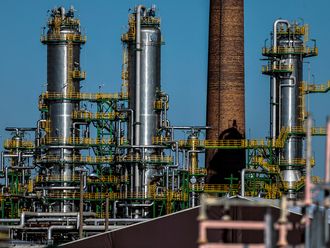London: Gold firmed on Tuesday as equities fell on fears that a Russian aid convoy heading to Ukraine could stoke tensions between Kiev and Moscow, and on signs that the stand-off was hurting confidence in the euro zone economy.
Anxieties over the Ukraine crisis and how this might impact future business hit economic sentiment in Germany, the ZEW think tank said on Tuesday, as it reported a fall in investor morale to its lowest level since December 2012.
That helped push European shares and the euro lower, while boosting German Bund futures.
Spot gold was up 0.2 per cent at $1,310.70 an ounce at 0945 GMT, while US gold futures for December delivery were up $1.80 an ounce at $1,312.30.
Russia said a convoy of 280 trucks had left for Ukraine on Tuesday carrying humanitarian aid, amid Western warnings against using help as a pretext for an invasion.
“The market is rangebound below last week’s highs, consolidating with some support from the ongoing geopolitical concerns over Ukraine and Iraq,” Andrey Kryuchenkov, an analyst at VTB Capital, said.
“The range is still quite narrow and the stronger greenback will limit the upside, also given relatively weak physical demand at the moment,” he added. “The market will be monitoring developments in Ukraine as Russia sends an aid convoy.” The dollar index rose 0.2 per cent on Tuesday, as the euro came under pressure from the weak ZEW data.
Gold has gained about 9 per cent this year, largely on tensions between the West and Russia over Ukraine, and violence in the Middle East. The metal is seen as an alternative investment to riskier assets such as equities.
The United States will consider additional military, economic and political assistance to Iraq once a new inclusive government is formed, US Secretary of State John Kerry said on Tuesday.
PHYSICAL DEMAND SLUGGISH Other than geopolitical factors, gold has struggled to draw support from elsewhere.
Physical demand in top consuming region Asia has been sluggish after a record year in 2013, while investors have been cutting positions in SPDR Gold Trust, the world’s largest gold-backed exchange-traded fund.
The fund reported a 5.36-tonne drop in its holdings last week, its largest outflow since early May.
Global economic data has also been strong, fuelling expectations that the Federal Reserve will raise interest rates sooner rather than later, increasingly the opportunity cost of holding non-yielding bullion.
Among other precious metals, silver was up 0.3 per cent at $20.06 an ounce, while spot platinum was up 0.2 per cent at $1,466.99 an ounce and spot palladium was down 0.1 per cent at $870.50 an ounce.
Palladium, which hit 13-1/2 year highs last month, is close to its most expensive compared to platinum since mid 2002.
“In ETFs, the preference for palladium versus platinum is clearer than ever this month,” UBS said in a note. “After both metals consistently enjoyed gains in ETF holdings over the last several months — albeit at a different pace — flows have diverged so far in August. Palladium ETFs are up by 6,000 ounces month-to-date while platinum ETFs are down by 10,000 ounces.”












